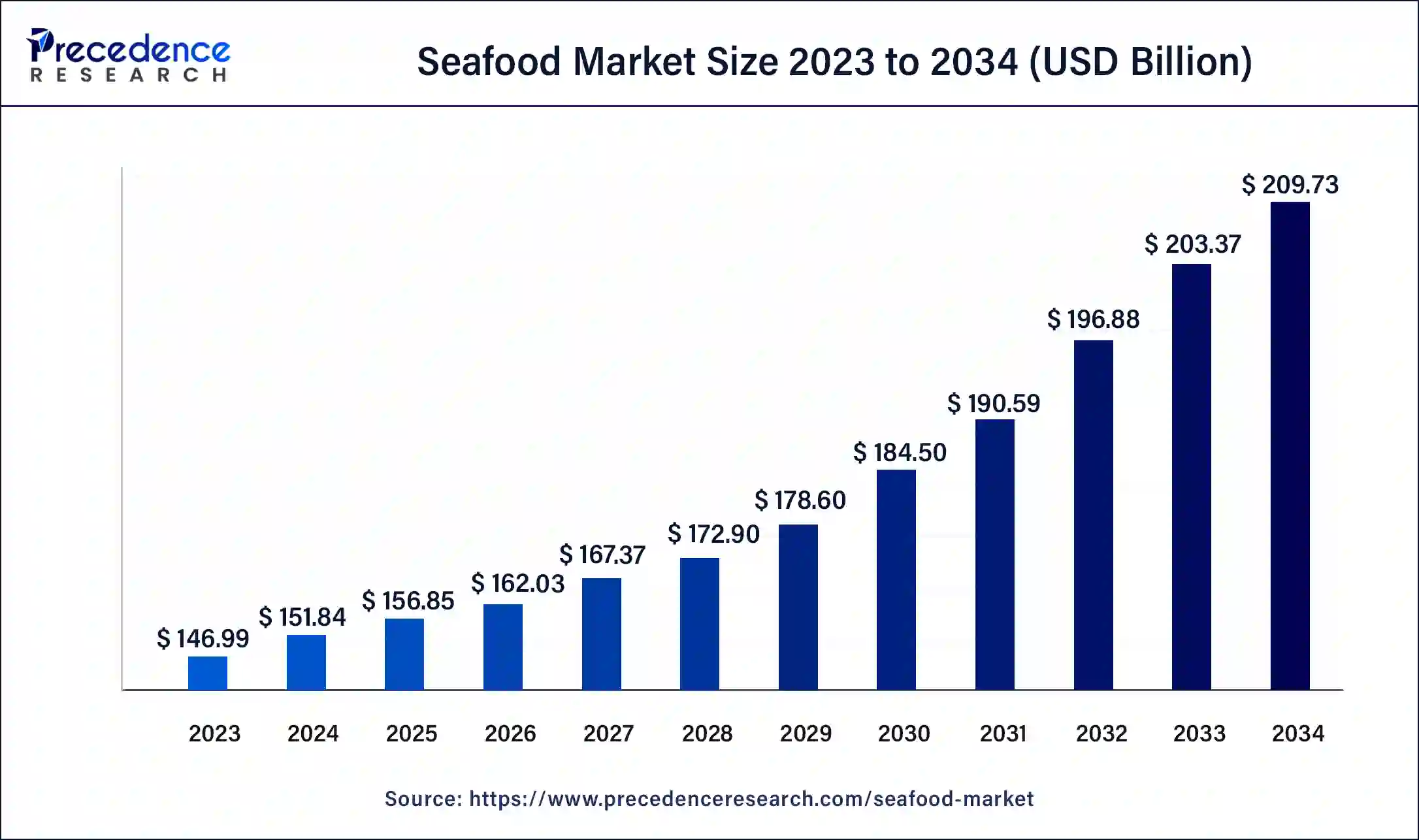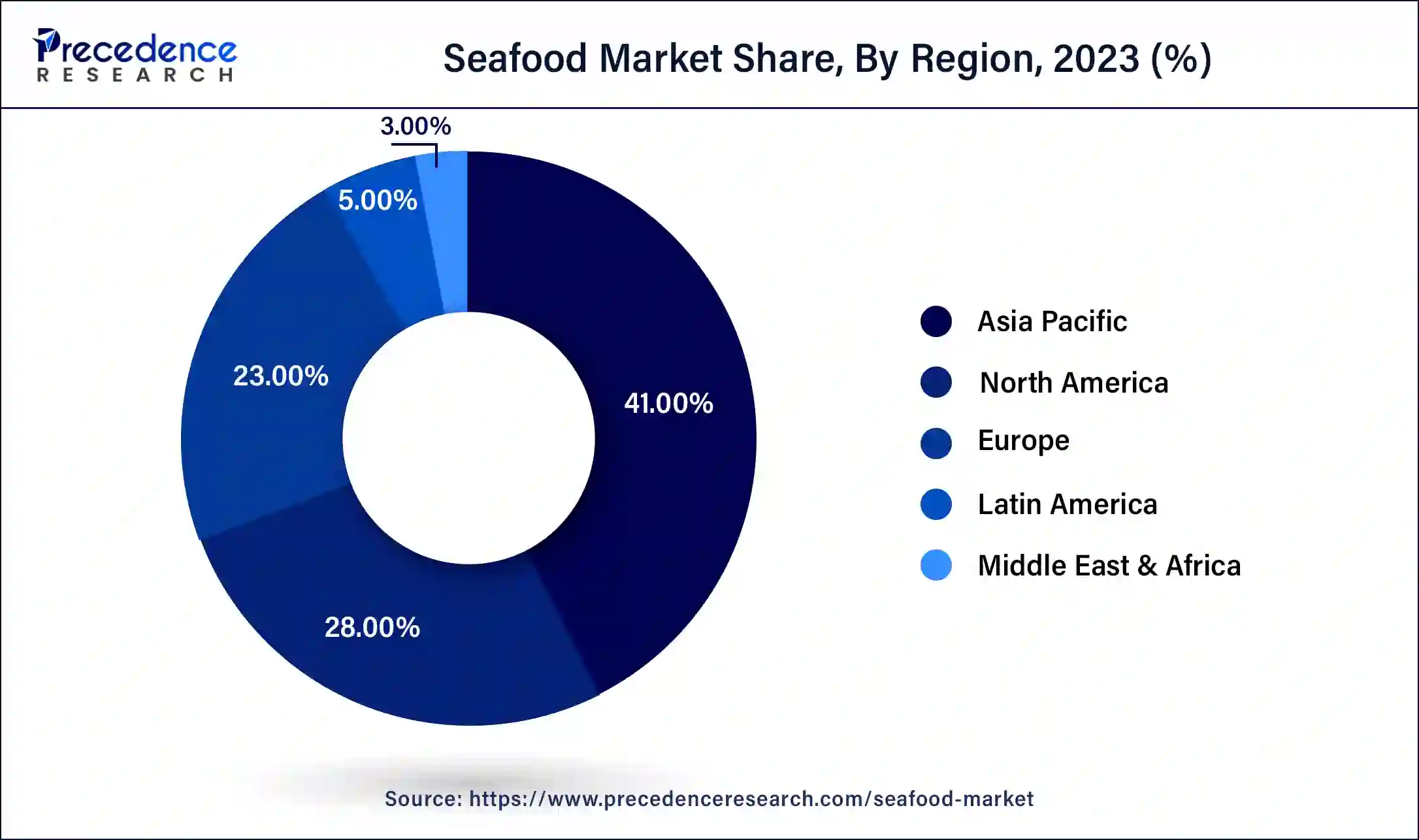August 2024
Seafood Market (By Type: Fish, Crustaceans, Mollusca, Cephalopods, Ground fish, Salmonids, Pelagics, Tuna, Others; By Application: Retails, Food Service, Institutions; By Nature: Organic, Conventional; By Source: Farm Raised, Wild Caught; By End Use: Food, Pharmaceutical, Cosmetics, Industrial, Biotechnology, Household Retail; By Category; By Distribution Channel) - Global Industry Analysis, Size, Share, Growth, Trends, Regional Outlook, and Forecast 2024-2034
The global seafood market size is estimated at USD 151.84 billion in 2024 and is expected to reach around USD 209.73 billion by 2034, expanding at a CAGR of 3.3% from 2024 to 2034.

The Asia Pacific seafood market size was estimated at USD 60.27 billion in 2023 and is predicted to be worth around USD 85.99 billion by 2034, at a CAGR of 4% from 2024 to 2034.

On the basis of region, the Asia Pacific market is the most prominent regional market for the growth of seafood. Asia Pacific market is expected to grow with the highest CAGR during the forecast period. As there is an increase in the disposable income and a rising number of fast-food restaurants that serve seafood this segment is expected to grow during the forecast period. Maximum revenue was generated in China in global comparison which was about USD 82.73 billion. The fish and seafood segment is expected to show a volume growth of 2.7% in the year 2023.
International trade plays a very important role in the economic development of the Asia Pacific region amongst the specific nations China is the largest exporter and fish producer. There's an increase in the production and export of seafood in many developing countries and this is expected to help in the growth of the Asia Pacific seafood market over the forecast period.

The global seafood market size is expected to witness growth during the forecast years as there is an increasing demand for exotic seafood and an increase in the number of restaurants providing seafood. As the tastes of the individuals are changing and the eating habits of the individual are also changing the demand for seafood will grow from various food sectors. Seafood is popular amongst many nations as it is an important source of protein fatty acids vitamins and minerals which are the best for anybody. Seafood consists of various aquatic animals, mollusks, and fishes. Fish and shellfish provide omega-3 fatty acids which are extremely helpful in reducing the risk of cardiovascular diseases. Omega3 fatty acids are extremely beneficial for hair and skin health. There's an increasing importance of domestic markets in the major seafood-producing countries and they shall help in contributing to the expansion of the seafood market. Various government policies which are associated with the expansion of the seafood industry is providing many opportunities for regional and local vendors.
During the pandemic, the seafood market had gone down drastically as all the hotels and outlets of seafood were closed down. Due to the restrictions imposed by the government and the social distancing norms the seafood market had a major downfall. As the dine-in restaurants were shut down during the pandemic the seafood industry was also largely hit
The demand for exotic seafood has grown drastically in recent years. Various varieties of seafood are offered across donations which helps in the growth of the global seafood market. The health benefits of seafood will contribute to the growth in the coming years. A growing emphasis on developing tasty and healthy seafood and increased awareness regarding the health benefits of the consumption of this food shell contribute to the growing demand for seafood. As new methods are used for fish breeding and different methods of fish traps are harnessing or increasing the growth of the global seafood market.
Seafood is a proteinaceous fat-free food that is very popular among consumers globally. An increase in responsible income and improvement and economic conditions shall propel market growth in developing economies. In the Asia Pacific and the North American market consumers are shifting their consumption to these premium goods and services. Many seafood restaurants are offering sustainable seafood options. Collaboration of the fish farmers or the fishermen with various retailers,’ distributors, or restaurants shall provide a solution for these environmental issues all of these factors collectively contribute towards the growth of the seafood market globally.
| Report Coverage | Details |
| Market Size in 2023 | USD 145.69 Billion |
| Market Size in 2024 | USD 145.69 Billion |
| Market Size by 2034 | USD 209.73 Billion |
| Growth Rate from 2024 to 2034 | CAGR of 3.3% |
| Base Year | 2023 |
| Forecast Period | 2024 to 2034 |
| Segments Covered | Type, Application, Nature, Source, End Use, Category, and Distribution Channel, and Region |
| Regions Covered | North America, Europe, Asia-Pacific, Latin America, and Middle East & Africa |
On the basis of the type, the fish segment had the largest market growth in recent years. The fish segment is expected to have a dominant market share during the forecast period. As fish is a high-protein alternative there is a growing demand and growing popularity of the fish segment across many developing and developed nations across the globe. As the number of meat eaters is increasing the demand for fish is also increasing due to the health benefits of eating it. Fish is a low-fat diet which is extremely beneficial as it provides omega-3 fatty acids. There is an increased consumption of fish across many nations with prevailing heart conditions. Omega three fatty acids are extremely beneficial for people with cardiovascular ailments. Fish provides a high protein low saturated fat diet. Vitamin AB and omega-3 fatty acids are extremely essential in maintaining health, especially in the eyes and the brain.
As the production or synthesis of omega-3 is not possible in the body it is extremely important that seafood is a part of the diet. The presence of omega-3 and fatty acids in the fish gives the brain a much-needed boost and also helps in keeping the heart healthy. The consumption of fish is increasing among people with dry skin in order to preserve skin moisture. The consumption of fish also helps in reducing joint stiffness and decreasing the stiffness due to arthritis. They have many anti-inflammatory effects for people with stiff joints. The demand for the Mollusca segment is also expected to grow with the highest CAGR during the forecast.
On the basis of application, the retail segment is the largest contributor to the market. The retail segment is expected to dominate the market during the forecast period. The increasing popularity of seafood and the benefits provided by seafood among consumers is attributed to the growing demands as an improvement in the supply channels and affordability for seafood the market is expected to grow across the globe. The retail segments provide convenience and various options like home deliveries this segment is expected to grow.
In many developed nations and developing nations, there are dual-income households. As there's an increased disposable income and low time for cooking meals the retail sector is expected to grow. Rapidly increasing fast food restaurants cafes and seafood outlets along with a growing trend of eating out on various occasions or providing a boost to the growth of the market.
Segments Covered in the Report
By Type
By Application
By Nature
By Source
By End Use
By Category
By Distribution Channel
By Geography
For inquiries regarding discounts, bulk purchases, or customization requests, please contact us at sales@precedenceresearch.com
No cookie-cutter, only authentic analysis – take the 1st step to become a Precedence Research client
August 2024